The Hamburg Triple, Part III: The Hamburg Cyclassics

The Hamburg Cyclassics
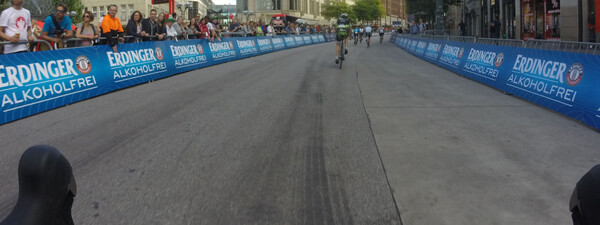
”Remember, this is the man who looked America dead in the eyes and said: “Bicycling is a very cool sport!” – and we f***ing believed him!”
– John Oliver about Lance Armstrong’s talent to lie convincingly, regarding his past of illegal doping
Granted, cycling is not a sexy sport. But it’s cheaper than a vasectomy. In recent years, doping scandals have seriously damaged the public image of the sport, and made people lose interest in it. I don’t think it’s fair, because in my opinion cycling can be seen as what it is, regardless of the professional liars destroying it. It is beautiful. A triumph of mechanical engineering to make human transport without an external power source as efficient as possible. To my knowledge, there’s no better way to harvest human power.
This is the Showdown
It’s the last part of my Hamburg Triple, after the Hamburg Marathon and the Hamburg Triathlons.
I have never taken part in the Hamburg Cyclassics bike race here in Hamburg, but most people I know didn’t believe that. I must seem like a guy who’s done it all before. But I haven’t. I was registered for the race twice before, though, but couldn’t participate both times, unfortunately. In 2011 a good friend of mine scheduled his wedding on the evening before the race, and in 2014 the Otterndorf triathlon surprisingly took place on the same date. I was a bit sad both times, but after all it’s just a question of priorities. I just wanted to do the other things instead. But 2016 shall be the year of my first ever cycling race!
What’s my Cycling History?
Basically none. I can ride a bike without falling off, for a start. But only when I started with triathlons in 2011, the bikes suddenly appeared to me in a different light. They’re more than my day-to-day method of transport now. My father-in-law Peter helped me build a racing bicycle some years back, because he is very good at that and I asked him. Back when I got more serious with triathlons, I bought a used special triathlon bike made out of carbon fiber on eBay, which is amazingly light and fast. I still use it for triathlons. Unfortunately, these fast triathlon bikes are not allowed in standard cycling races, which is why I built a third bike with Peter. He gladly helped me search for good parts and assemble everything. I was very pleased with the result, when we finished the project this spring.
I’ve never trained much for cycling, but still managed to do the 180 kilometers of the Ironman in 2015 somehow. It’s probably because of the good triathlon bike I used.
What about the Cyclassics?
Hamburg and the Cyclassics race have a close relationship. The event was started by Christian Toetzke in 1996. A guy who was beaten by me during the last Hamburg Triathlons. Its popularity grew quickly not only for pros, but also for amateurs. The pro race is usually held on the same day and roughly on the same course, but is quite a bit longer. About 250 kilometers. It’s Germany’s only big pro cycling race, and a huge deal to the international cycling scene as well. It’s part of the UCI world tour since 2011, which features 27 races all over the world. Pros can collect points and after each year a winner emerges.
The amateur part of the race is held on the same date as the pros’ race each year, and offers 3 different race options: 55 kilometers, 100 kilometers, 155 kilometers (which just includes the courses of both smaller options after one another). I know lots of people who have done one of the races before. It’s like a sporting event for everyone, especially the 55 kilometer option. Many people do the race year after year as well. One of my partners, Martin, for example, got to 9 completed races so far. After 10 participations, you’ll receive some special treatment, but who knows if he’ll ever get there!
These days, the 3 amateur races have a combined number of participants of an incredible 20,000 people. So it’s safe to say that cycling still is popular among the general population.
Cyclassics Problems
Earlier this year, two unusual things happened to this otherwise very stable event: it lost its long time main sponsoring company, Vattenfall, and got bought by the triathlon company IRONMAN. This sounds like the sponsorship problem must have disappeared, but it hasn’t. IRONMAN is a very successful company, but it wants its events to be successful on their own, too. So there really was a bit of a panic in the months leading up to the race this year, because no company could be found to sponsor the whole thing. It almost got cancelled, but then a company named “EuroEyes” (specializing in laser eye surgery) picked it up and saved the day. I’ve never heard of it, and to be honest, it seems a bit weird to me. But who cares, they bring in money and we can cycle.
You might think that races like these are being paid for by the amateurs who pay good money for entrance into it, especially if it’s as many as 20,000 participants, but that’s not the case. Hosting an event like this requires a much bigger wallet. Sponsorship by many entities is very necessary, otherwise there would be no such events. EuroEyes will pay for a big part of the Cyclassics in 2016 and 2017, and holds an option to continue for 2 more years. Hopefully it’ll work out so we can keep this international and very big event in our city.
Differences Between Triathlon Cycling and Traditional Cycling
As my experience with cycling races is exactly zero, I know a bit about triathlons. But there are some significant differences between the cycling part of a triathlon and a standard bike race like this one is.
First: Drafting. At a triathlon, you’re not allowed to follow right behind another athlete to save energy. It is considered to be unfair because you’re leeching off of the power the guy in front of you must use. At these high speeds, that’s a significant difference. People say, it feels about 30 percent easier to go behind someone than to directly fight the air resistance. Even more so, if you’re faster, of course.
Second: The bike design. Related to the drafting law, you are not allowed the very aerodynamic position of a triathlon bike handlebar, because the brakes are more difficult to reach. Because you’re allowed to draft behind everyone you want in a standard cycling race, you need good instinct on when to break. Reflexes will save your life, quite literally. At a triathlon race, with the minimum gap of usually 10 meters between every bike, you have plenty of time to react if something goes wrong in front of you. Here, you don’t.
Actually, there’s a whole set of rules and regulations specifically regarding the bike design, but they are very complicated and bureaucratic. It can be translated into: “if it looks like a bike usually looks, it’s probably allowed”.
These differences, especially the drafting rule, changes everything about the race. I’m very interested about how this will go.
100 or 155?
So, the Hamburg Triple (which I’ve made up) includes the 100 kilometer or the 155 kilometer option of the race. The 55 kilometer option is part of the Small Hamburg Triple, which I’ve also just made up. So, which length do I register for? My first instinct was: 155, of course! So I did just that. But during my very few training sessions I got cold feet. Cycling on a non-aerodynamic, non-triathlon bike is very different, so much that I’m quite a bit slower. It’s also a lot harder on the arms and back, compared to the triathlon bike. I would have needed to train a lot more to easily pull off the 155 kilometers in this body position, I thought.
Then, in the weeks leading up to the race, I found out about another problem: there’s a minimum speed set for all 3 race options, 25 km/h for the 55 km’s, 26 km/h for the 100, but a very fast 34 km/h for the 155 kilometers! Probably because they don’t want to keep the course closed for traffic that long. In my training sessions I was happy if I got over 30 kilometers per hour on average, so this was the last nail in the coffin. I went on eBay and immediately found a guy who was willing to exchange his 100 ticket for my 155 ticket. It all worked out very easily, so I was looking forward to one hundred kilometers of cycling.
Weirdly, on the last day before the race, this minimum required speed for the 155 race was apparently reduced from 34 to 31 km/h. Now this sounded quite a bit more doable to me. But switching up again to the long race wasn’t possible anymore, so I just went with it.
What a Huge Event
I was blown away by the size of this event. Compared to the 22,000 marathon runners in April, or the 10,000 triathletes (and 250,000 spectators) in July, this was a different league. The whole of Hamburg’s city center seemed to be involved. On every empty space there were some temporary tents or something similar related to the race. The day before the race I went to collect my starter’s bag and explored everything.
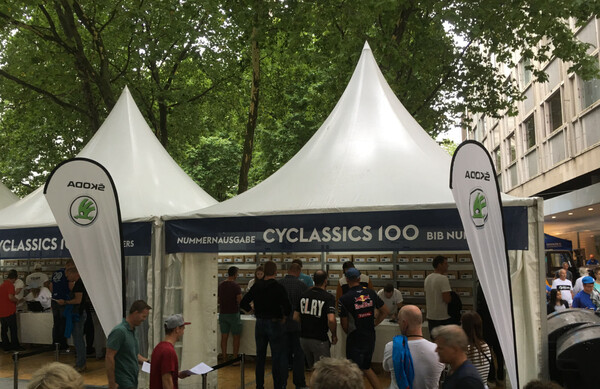
It was already a day packed with little warm-up events and the whole city was on foot taking part in it. Quite cool. Music and MCs to be heard everywhere. The city full with people on bikes.
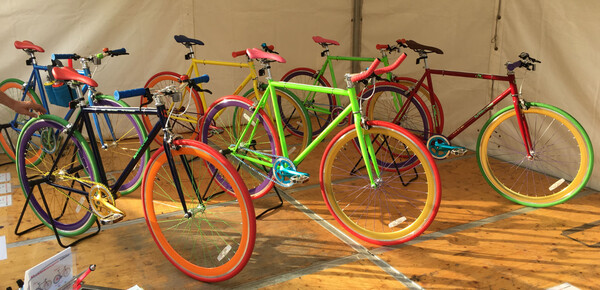

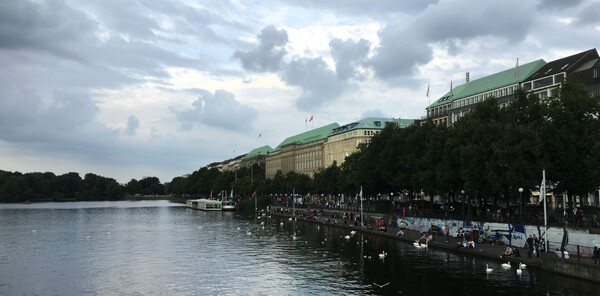
Race Day
This shouldn’t change. On Sunday, the 21st of August, it begins. My starting block would leave at around 8:20, so getting up early was required. Some muesli, and off I go on my bike to the Hafencity quarter, where the start is located.
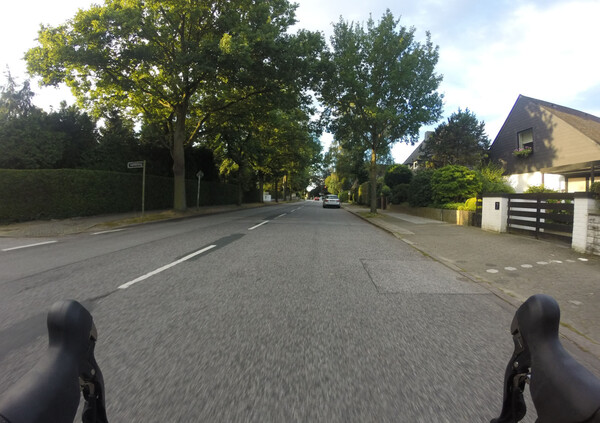
My wife and kids didn’t make it this time, because it would’ve been too much of a hassle to come with me this early, only to see me leave and not return for a few hours. Biking races are often not very spectator friendly, compared to marathons or triathlons.
So I got some me-time and pedaled the roughly 10 kilometers to the race start. On these empty streets closed for the race, it’s been a nice experience to cycle along.
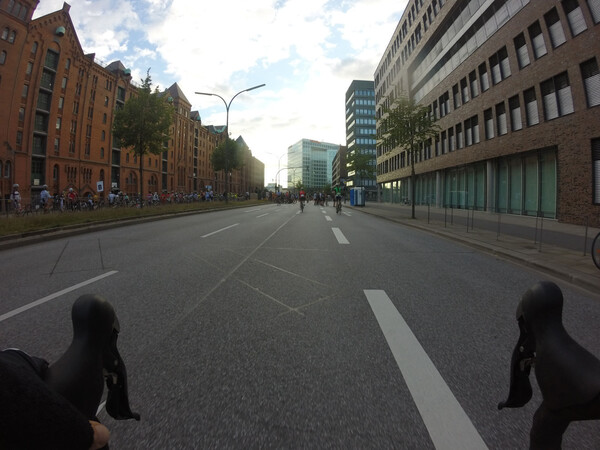
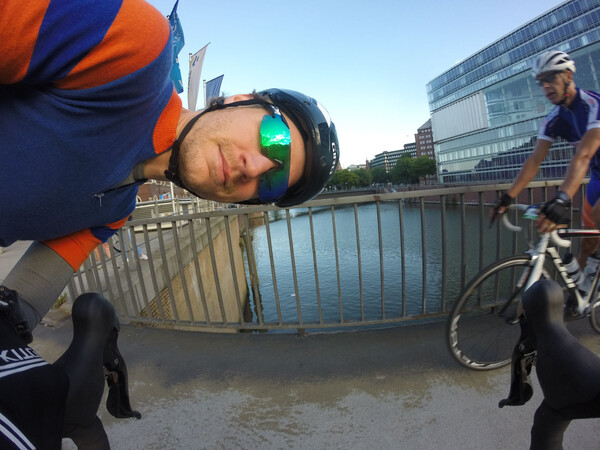
The area was already filling up with people on expensive carbon bikes wearing colorful tight clothing. The biking scene! I’ve never been part of it before. It feels strange. I feel I’m not really one of them. I’ve got my self-built vintage bicycle including a beautiful 30 year old Japanese Centurion steel frame, and I’m wearing an original 80s cotton bike shirt my father-in-law handed down to me. No company logos on this one. People notice me immediately, I look very different from everyone. A guy next to me says: “Well at least you look authentic.” – this doesn’t sound like a compliment!
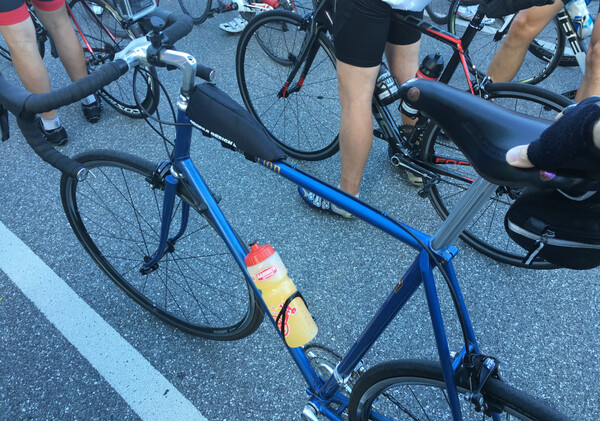
The bike’s frame and my shirt were made before I was born, so I don’t think I’m being authentic today. But again, who cares! I’m just here to ride a bike for a long time and to see how that goes!
I must admit though, I had hoped for more guys on beautiful old bikes just enjoying the time like at an Oldtimer race, but they all are very serious about it. All this plastic on the bikes doesn’t look too good. I’m a bit envious about the cool high profile carbon wheels most of them have, I must admit. But why all the company logos on the clothes? No one here is sponsored by any of the companies. I don’t get it. I prefer my very plain, two-color, 80s cotton shirt.
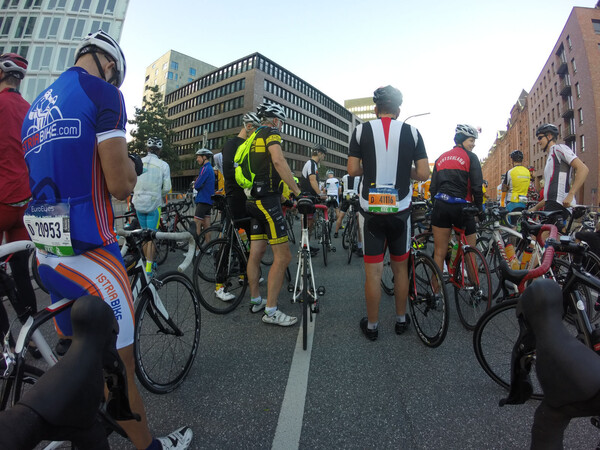
It’s getting exciting now, just a few more minutes to the start. It’s done in waves, because 20,000 people on bikes going through a small gate at the same would lead to an insane amount of accidents. Timing chips are attached to each bike, so everyone will be tracked exactly as they go through the starting gate, no need to rush. It’s a very good system. The first groups roll off, just a couple more minutes, and then I hear the sound of hundred of cyclists clicking into their pedals with their bike shoes. And so do I. And off we go.
The Hamburg Triple, Part III, Starts
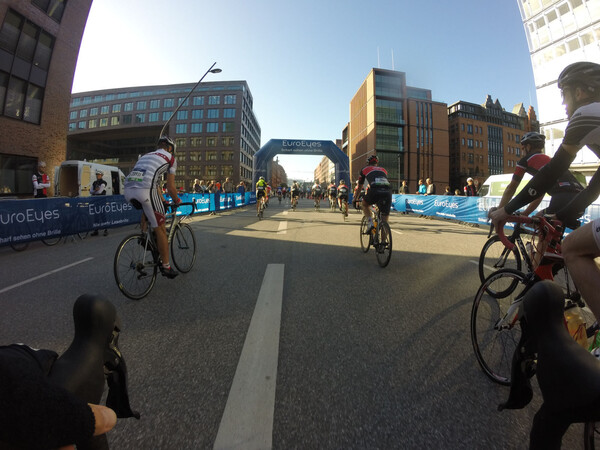
Rolling through the gate in the perfect weather is quite the experience. A deep sitting sun from the front, blue sky and no winds make it easy to enjoy. The beeping sound of the chip-tracking machines do their job of telling us racers it’s starting. Many of the people around me interpret this as a command to really step into their pedals as hard as they can, and off they go.
I am a bit more careful. After all, this is my first cycling race and I’ve got 100 kilometers in front of me. Better to take it easy in the beginning.
Group Dynamics
Very soon I get to experience the very interesting group cycling behavior. It’s a bit like a hive of bees. Everyone kind of works together to achieve a better result for the group. As I explained, drafting makes a huge difference during cycling, so when you’re surrounded by cyclists in every direction, there is almost no wind or air resistance noticeable. Thus, you go a lot faster with the same effort, while the cyclists in front of the pack do the work. If you do it correctly, the people in front would switch every couple minutes, to give them time to relax, while fresh new ones from behind will fight the air up front during the next few minutes, until they are exchanged, and so on.
But in my experience today, that only happened very rarely. People just went as they liked, not communicating or optimizing. We humans clearly are not as well organized as ant colonies are. But it’s still a huge advantage for almost everyone.
With 20,000 riders, there are many different groups of people forming automatically at the beginning at the race. All have different speeds, and sometimes overtake a whole other group completely. That all kind of happens because it’s bound to happen, not because someone really planned it. That is what makes it interesting. There is very little talking or thinking involved. Everyone goes at their comfortable speed and will eventually fit into a certain group.
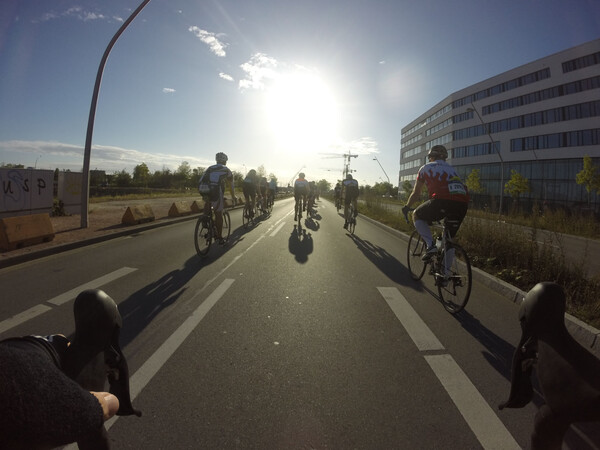
At the very beginning, everything is still rather chaotic, with the faster racers overtaking all the time, and slower racers being passed by. To me, it seemed at first that I must have been quite slow compared to the average, because many people came by. I lost a few groups, because they were just too fast for me. So every couple minutes I would be alone on the course, with a group a few hundred meters in front, and another coming up from behind. Being alone is a bad feeling here, because it means you’re going a lot slower without someone in front fighting the air for you. In my case, it’s the difference between 35 and 30 km/h.
Lose a Group: be 5 km/h Slower
So sometimes I tried to keep up with a fast 38 km/h group which was passing me by, but after a while I had to admit to myself it’s too fast for me to sustain for the next 90 kilometers.
Then, a few times another interesting thing happened. As I get slower and see the group I’ve lost disappear in front of me, fighting the air on my own again, I look behind me and notice that there’s a whole group right at my own rear wheel! I’m now the air-fighting guy in front of a big group! And maybe have been for a while already. As I realize that, I try to go slower so people from the group overtake and take the lead instead of me. Saving energy. Tactics is quite important.
As much as cycling seems to be an individual sport, races like these confirm it’s a team sport. It’s much easier to understand why people at the Tour de France, for example, who tried to escape from a pack to lead the stage, eventually get caught in the end by the pack most of the time. You stand no chance on your own.
The Only Exception: Hills
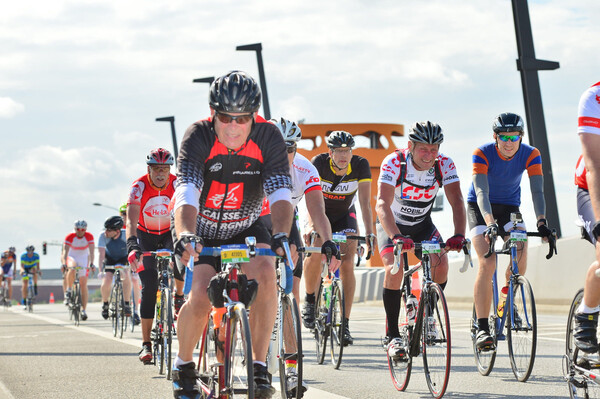
After about 10 kilometers, we’re crossing part of the Elbe river on Hamburg’s iconic Köhlbrand Bridge. The highest point of the road on the bridge is 53 meters, and the whole bridge is visible from many parts of the city. Because of its height, good views are guaranteed. To achieve that, one first has to climb to the top. And this is where the packs dissolve, because uphill the individual strength plays a bigger role than air resistance, especially because the speed is way down.
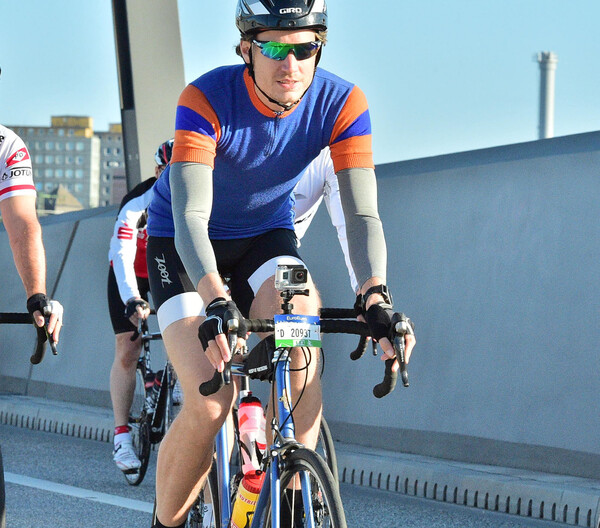
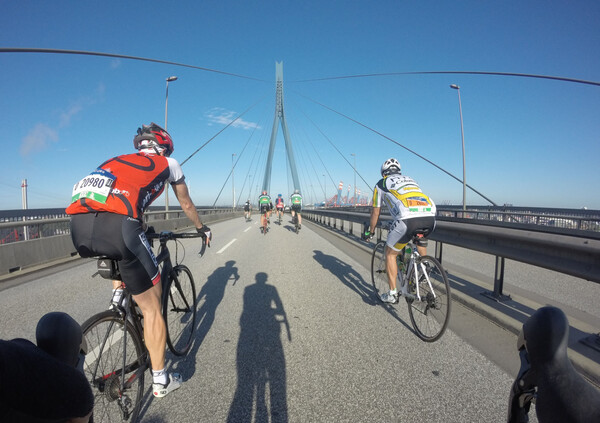
My father-in-law Peter told me to save my energy for the climb here and the following few hills as well, so I took good care of that. In the end it seemed easier to me than expected. And it definitely was a very nice experience to cycle across this bridge, which is closed for pedestrians and cyclists year-round. The downhill part after reaching the top was great as well, as you can probably imagine. 60 km/h.
It’s still hard for me to find a group with a speed I like, this far into the race. But I guess it will happen eventually. I spend maybe 70 percent of the time within groups, so it’s a lot better than being on my own all of the time.
A forrest section follows, along with a few more little hills, but it’s all good.
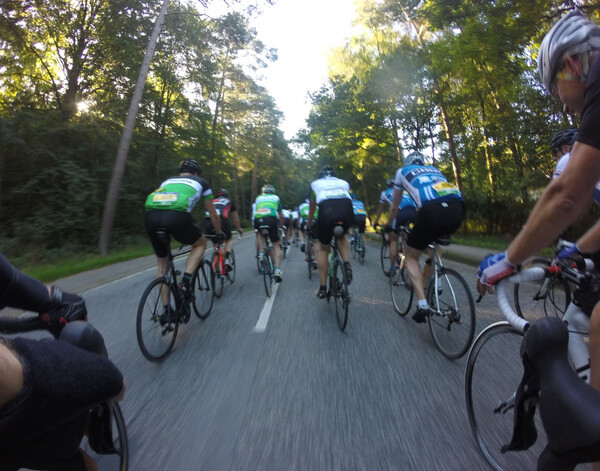
Visitors!
At one of the highest points, maybe 20 kilometers into the race, I am greeted by my two in-laws! Susanne and Peter live in the area and came by to see me. That’s very nice of them. They offer food and drink, but I had packed it all. Their presence gives me quite the boost after these hills.
The Country-Side
It’s getting more quiet now, 30 kilometers are done, there is next to no wind and the course slowly flattens. It’s very enjoyable. I could go like this all day, I think. The air is pure here outside of the city, there are agriculturally used fields around, everything is peaceful.
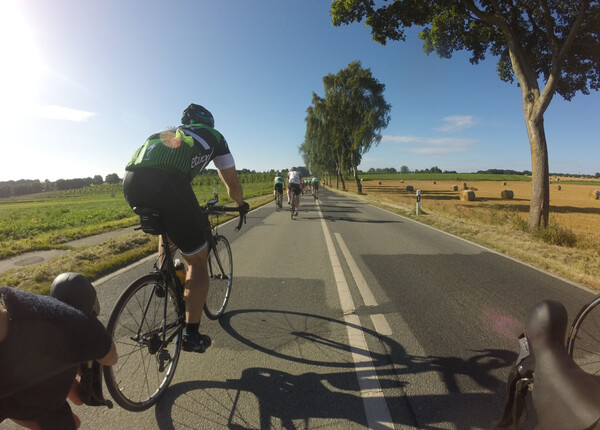
Like a caterpillar or a swarm of fish we travel through the country. I keep coming up with animal equivalents. Probably because it feels so natural and raw, to move forward like this. You also don’t realize how fast you’re moving within the group. You only see people around you going at the same speed as you are, so it almost seems like you’re staying in the same place. The upcoming street quality is hard to see, too. I roll through so many more little bumps in the streets than I usually would. Simply because there is no time to react between seeing them one meter in front of you and hitting them with your front wheel. It’s quite the workout for arms and back to smooth out the bumps. Not too annoying, just new.
Nutrition?
As always during long exercise or competitions like this one, it’s not easy to make sure you don’t get so hungry you can’t go anymore. During marathons I have my energy gels, during the long triathlons I pack some chewable sugary bars as well. But here, I opted for my favorite energy gel again, which is HoneyPower. It’s based on honey, completely natural, and just tastes good. I’m glad to say I didn’t run into any problems with my body during the race. HoneyPower really helps. You just don’t have to think about nutrition, if you have a package of HoneyPower every 30–45 minutes. It’s all just going to work.
Biking is Dangerous
A couple people aren’t as lucky going in the groups, though. I see about 3 or 4 little accidents along the course. Many friends warned me that this type of race can be very dangerous when you’re this close to everyone going at high speeds. Sure, some accidents are bound to happen. I was expecting more of them, though. And it didn’t look too bad, the ones I saw at least. No life-threatening stuff.
Suddenly some guy in the vicinity is telling his friend next to him: “we’re half-way there, now!” – already? It doesn’t seem like 50 kilometers. But my watch says so, too. At 53, there’s the one and only nutrition station. This also happens very differently from a running race: a kilometer before the station there are signs, telling you to switch lanes according to your preference. Then, I have to take the right lane, slow down, and leave the street to a parking space as if I were a car leaving the highway for a gas refill. The parking space is full with food and drink. Oranges, bananas, water, isotonic sports drinks, that kind of stuff. Some people have even put their bikes down and walk around here, enjoying an extensive break, I guess. I just let a friendly volunteer refill my bike bottle with some iso drink and keep going.
Of course I’ve lost my group because of this 20 second stop, but another one flies by as I step into my pedals again. At maybe 200 people, it’s a rather large one. They were just here and keep moving fast. 100 meters between me and the last guy of the group in front now. This means fighting. If I lose them I don’t know when the next good group will follow. So far along in the race the people are scattered more and more. So I opt for pedaling really hard until I reach them.
A Small Town To The Rescue
I keep getting closer, but it’s really tough now. I know that once I’m inside the group, it will get a lot easier, so it’s the probably the best decision to do it like this. But man, is this hard! Then I have a bit of luck: we enter a small village, which means the street is getting more curvy. Cyclists tend to go on the best possible line, the “racing line”, so during curves they all go to one side of the road. Which means some will have to brake a bit. Therefore, the pack stretches out and becomes a lot longer, depending on the nature of the curve. And herein lies the big advantage for me. As I am alone behind the group, I don’t have to brake and try to find a spot in the group to get close to the racing line during curves. I can go full speed. So this makes it really easy, and after just a few of these curves, the remaining 50 meters are gone. I’m integrated again. I try to get to somewhere in the middle of the group to not get lost again, and that works out fine, too.
The other truth of this phenomenon is the part after curves. There, the pack accelerates quickly and sometimes you have to really step on it in order not to lose the guys in front again.
Pavlov’s Dog
Somewhere a long theses kilometers I catch myself having a weird though all of a sudden.
“Man, I’m really looking forward to that Erdinger beer in the end!”
What?! A couple years ago it would never even have occurred to me to have one of these alcohol-free beers. I would buy them by accident and then give them away. Who needs that stuff.
But their marketing strategy is outstanding. Almost every major sports event in Germany and some neighboring countries is sponsored by them. Logos everywhere. And they run a professional triathlon team as well, with some world-class athletes in it. Beer and sports? An unusual combination. But apparently alcohol-free beer is isotonic in nature, and a good source of several other nutrients, so it can help with regeneration after an intense sports sessions.
What Erdinger does, apart from painting their logo absolutely everywhere, is to give out free beers to every finisher at major events. And who doesn’t like free stuff? After a race, something ice-cold to drink that resembles beer? Why not! So, I always had one, if they were available after a race. Just never thought about it. Until now!
That’s why this thought entering my brain surprised me and, quite frankly, scared me a little. Erdinger successfully manipulated me. I really like this stuff now. So much, that I’m looking forward to it during a race, even. Kudos to you, Erdinger. Flawless marketing, well done! Something to learn from.
Still Some Work To Do
But first, cycling. 30 kilometers are left. This part of the race is beautiful, still. The sun is out, it’s nice and warm. I’m fully integrated into the bike racing tactics now, it’s seems to me like I’ve never done anything else. It just flows. I notice the beauty of traveling like this. No smelly gas, no noises whatsoever, just the plain rolling sound of the rubber on the pavement. This is what transportation should be like.
Coming closer to Hamburg’s southern outskirts now. Some more houses as we approach my wife’s and in-laws’ home quarter Harburg. That also means more curves and more road bumps. But it’s all good, up until we unexpectedly reach a short patch of cobblestone! It’s maybe just about 20 meters long, but everyone is grunting fearfully as we are shaken well like a cocktail James Bond would enjoy. A lot of bottles and other equipment strapped to the bikes just falls off and gets lost or even becomes a hazard to the following cyclists. A couple meters in front of me, a bottle falls off, and immediately another guy cycles right over it, causing it to explode. A fountain of sports drink wets some more bikes. Dangerous!
Everyone around me is still okay, though. No harm done. Then, a couple hundred meters later, another stretch of cobblestone! This time, people were expecting it. All went up out of their saddles, firmly gripped the handlebars and just pulled through. It’s much easier if you’re not taken by surprise.
Entering The City
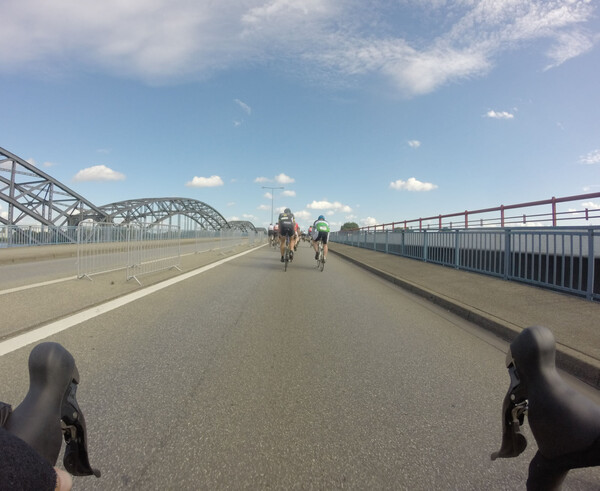
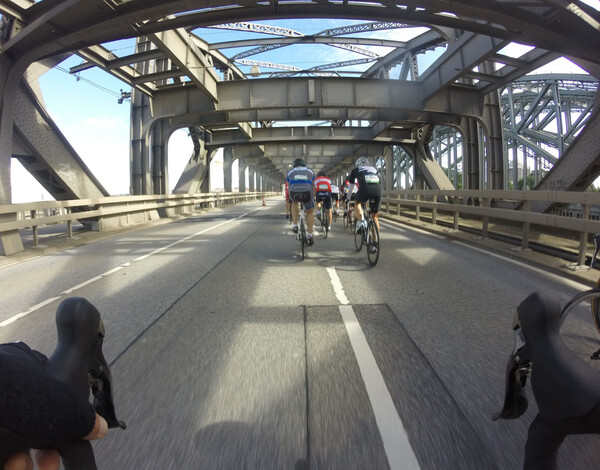
The last 20 kilometers just fly away. We come across so many places familiar to me. Suddenly we’re already at Hamburg’s central train station. Here you have to remember if you’ve signed up for 100 or 155 kilometers, because you’ll required to change lanes according to your plan. In earlier days of the race, you were allowed to choose as late as right now, which I would have really liked, because I feel so good that I would have went for the 155 right now. But this year, I would’ve been disqualified if I did so. Left lane, 100 kilometers for me.
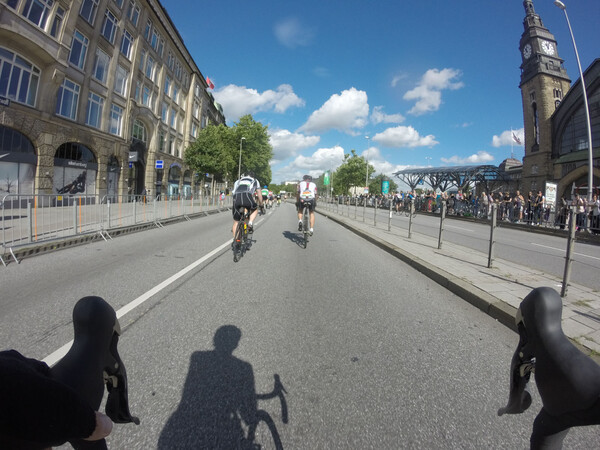
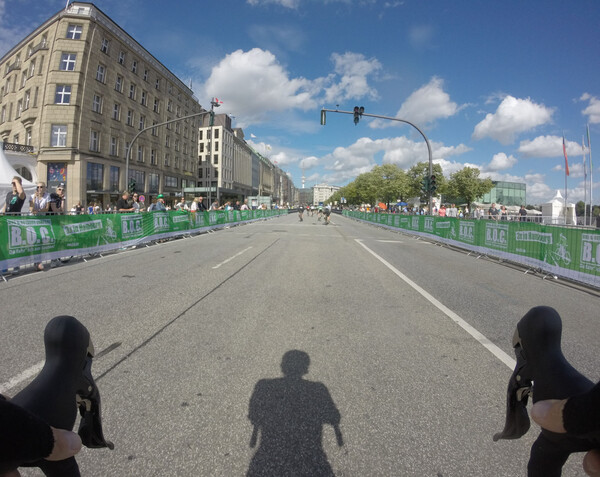
Außenalster and Jungfernstieg. A place which is essential to all three Hamburg Triple races. The Marathon, the Triathlon, and the Cyclassics today.
Hamburg is beautiful.
Another short loop right through the city center, crossing Gänsemarkt. The groups have dissolved by now. Cyclists are scattered along the streets, some in front, some behind, but not close to each other. I guess on the last few kilometers everyone just wants to enjoy the scenery and not be as efficient as possible.
It’s a one of a kind experience to bike through the closed city center of a 1.8 million people city, on the middle of the street, while people applaud from the sidewalks. It’s impressive.
The crowds are getting bigger and louder the closer we get to the finish line on Mönkebergstraße. And there I am, the last curve at Rathausmarkt, finish in sight.
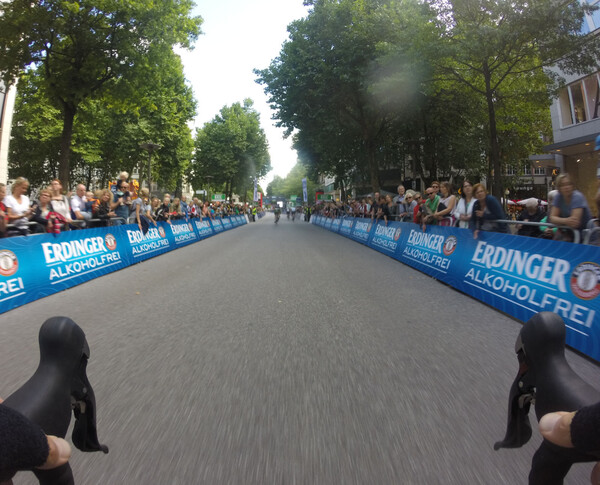
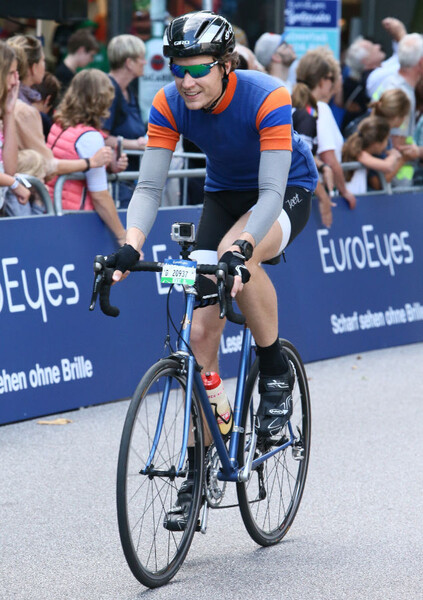
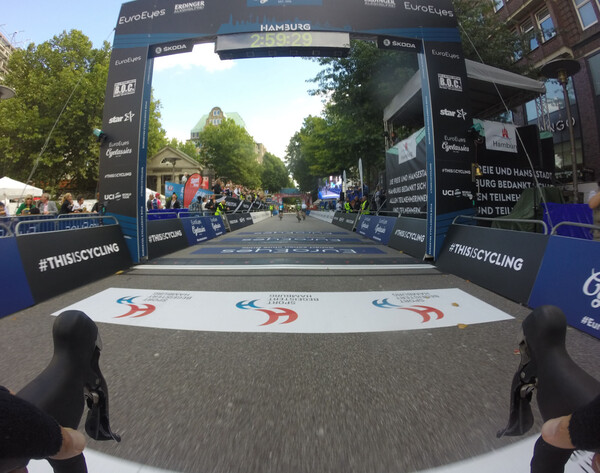
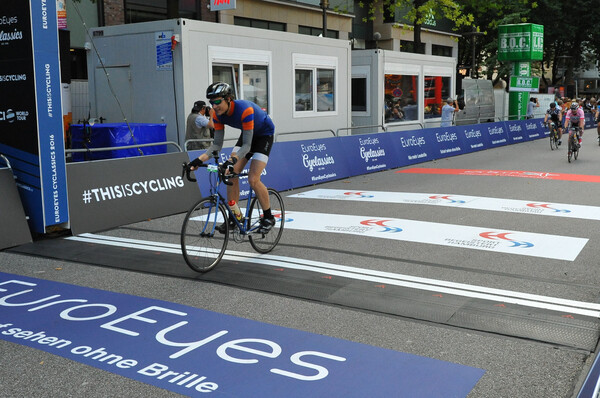
Wow, what a great race! I feel a bit lonely because no one is here to celebrate with me, but you can’t have it all. Still, it’s been a wonderful 3 hours. 2:49:25, to be precise. Which means an average of 35,5 km/h total! 70 percent of the male participants were slower than me. I guess I’m not as bad a cyclist as I thought before. I would’ve never thought I could do that. It’s definitely the power of group cycling. Now I’m sure I would have been able to do the 155 as well, easily within the time-limit. Next year!
Right after the finish we’re diverted to go a few hundred meters more through the city center until we’re reaching a place where we’re handed a medal.
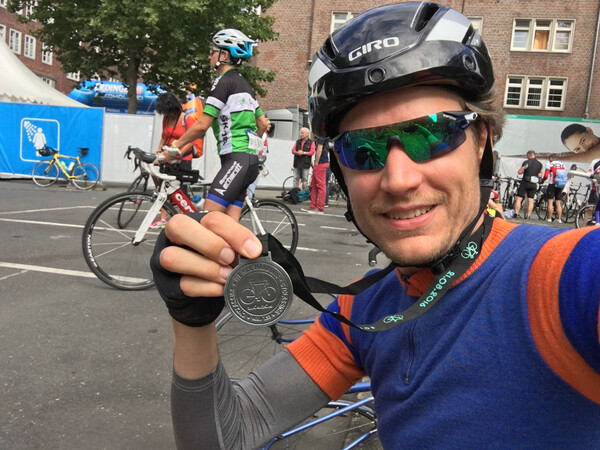
From that place I can see something familiar: a huge Erdinger gate. Sure.
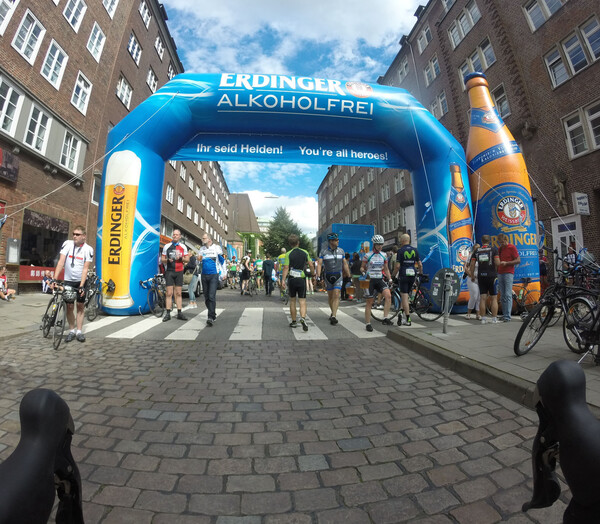
It is delicious, I can’t say anything else. Tastes like victory, haha!
Conclusion
Hamburg’s Cyclassics is a great event I can recommend to anyone who likes to bike. It’s really not as hard as it sounds and also exciting to see the whole city transform into a cycling playground for a weekend. Still, nothing beats triathlons!
The Triple is Done!
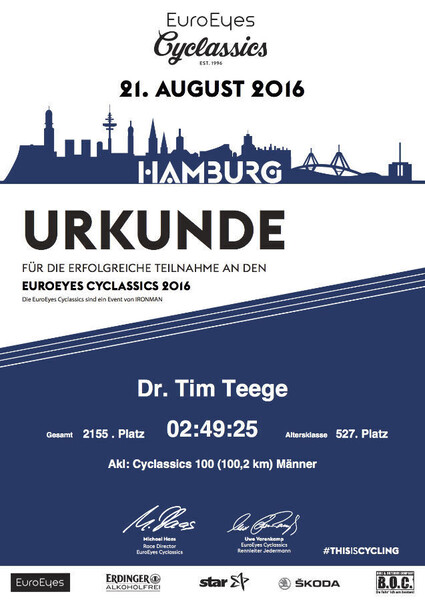
First time try, it worked. I guess I’m lucky! It’s been a great summer, and I can recommend trying the Triple yourselves. Maybe start with the small one, if you’re not into sports this much. Some friends and I are thinking about making the Triple a recurring event, handing out specials medals for all Triple finishers, by the way. Let’s see how many people we can get to participate! It’s all lots of fun.
On to next year, when I’ll try to repeat the Triple, this time including the 155 kilometers Cyclassics, obviously!
Thanks for reading everyone. It’s been a good summer with lots of nice events.
I’m looking forward to the upcoming marathons in the fall.
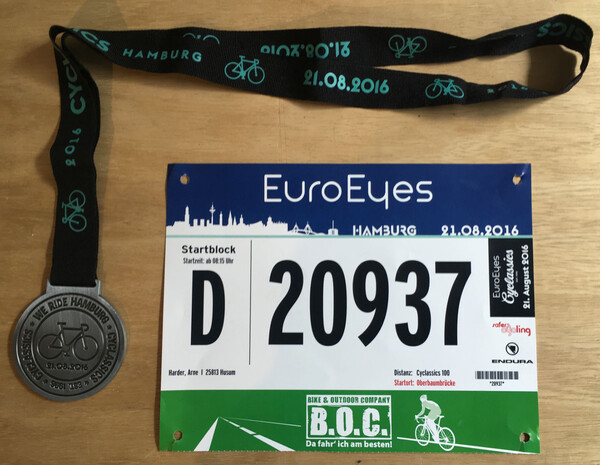
How do you feel after reading this?
This helps me assess the quality of my writing and improve it.
Leave a Comment